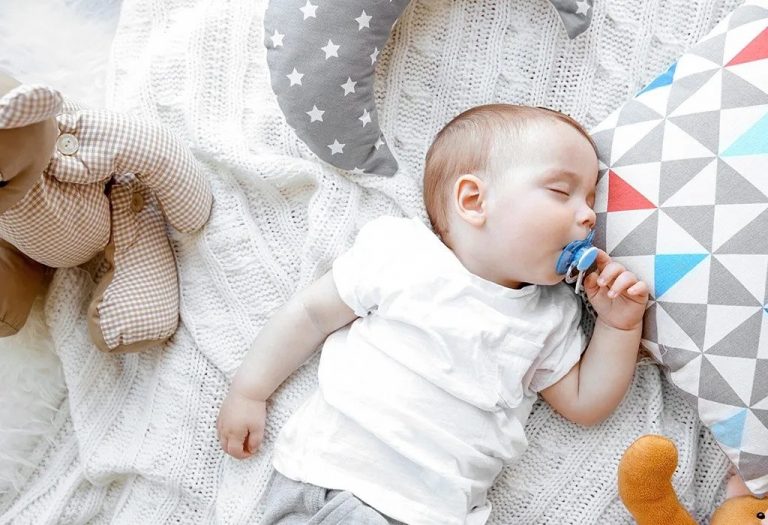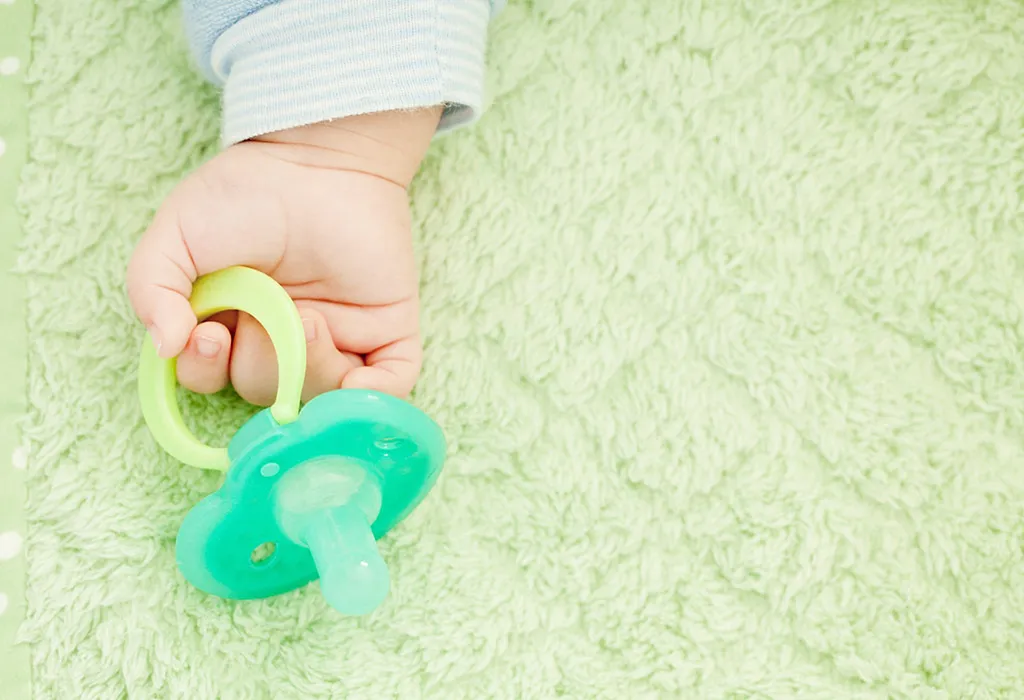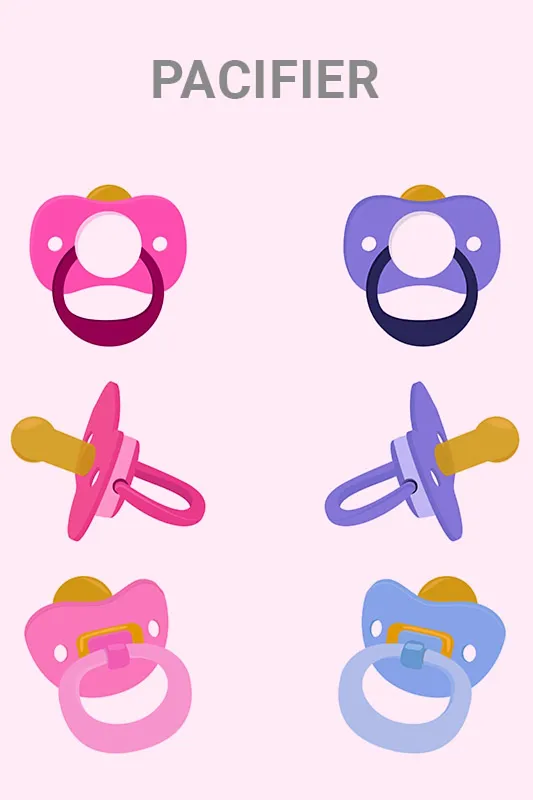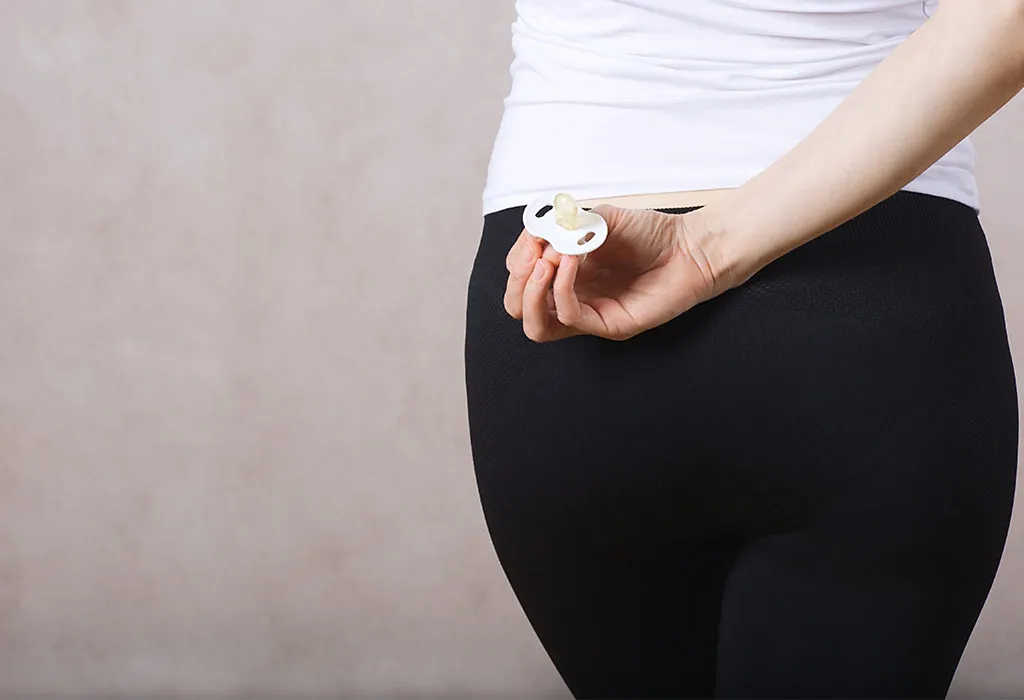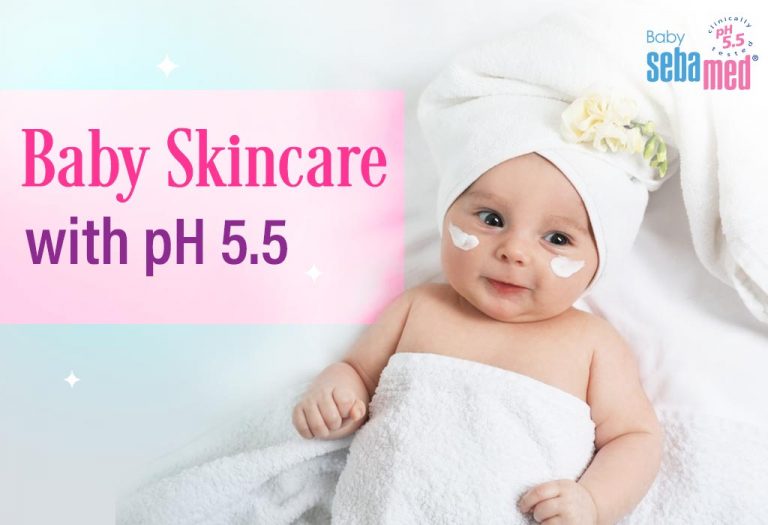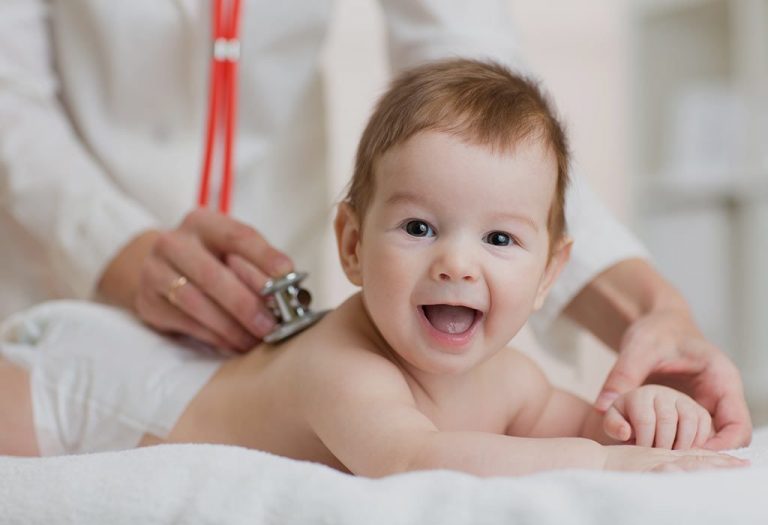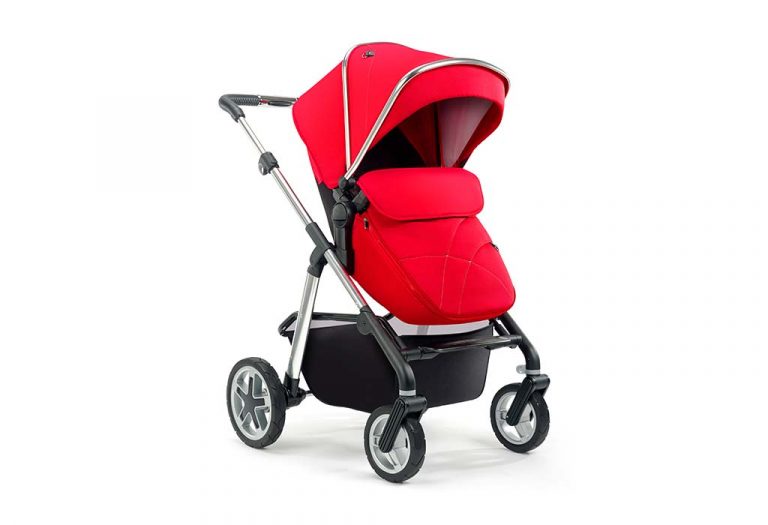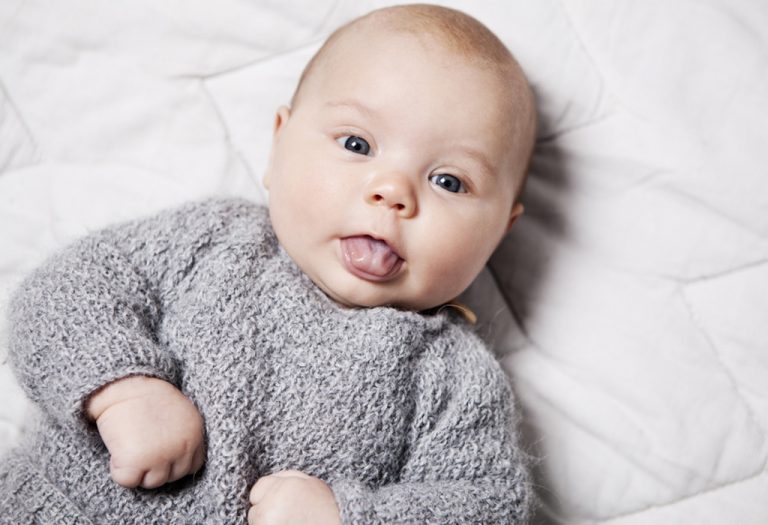Pacifier For Infants: Benefits, Risks & Tips To Use Them

Your baby may seem annoyed for many reasons besides basic hunger. These unexplained needs of a baby can be soothed with a pacifier. Baby pacifiers impart a sweet taste that makes the sucking experience pleasant and calms a fussing baby down. However, parents often need clarification about when to introduce pacifiers for infants, when to stop them, and other queries concerning the child’s health. These are understandable concerns that will be discussed in the coming sections. Even though pacifiers make both a baby’s and the mother’s life easier, there are many things that new parents must be careful about and consider when using pacifiers for newborns.
What Is a Pacifier?
A pacifier, also known as a soother, teether, or binky, is an artificial nipple made of rubber, plastic or silicon. It is supported by a handle that often works like a rattle. In the olden days, such pacifiers carried a spoonful of sugar or any sweet item at the tip of the nipple. As the name suggests, a pacifier pacifies an irritable baby.
Why Do Babies Like Pacifiers?
Babies are naturally drawn to pacifiers for multiple reasons. Sucking on a pacifier provides them with comfort and security, as it taps into their innate reflex to suckle for nourishment and soothing (7). Additionally, pacifiers offer oral stimulation, allowing babies to explore and learn about their mouths. However, using pacifiers for infants within limits is crucial, as prolonged use can lead to dental problems or difficulty breaking the habit later.
Should You Give a Pacifier to Your Infant?
Many parents wonder, “Can you give a newborn a pacifier?” Well, the answer is yes! Giving your baby a pacifier can be a good idea. It can help calm them down when they’re upset or help them fall asleep easier. Pacifiers are also handy for keeping your baby distracted, like during doctor visits or travelling. But not all babies like pacifiers, and they can cause problems if used too much, like with their teeth or if they become too dependent on them. So, it’s essential to consider what’s best for your baby and weigh the pros and cons before deciding whether to use a pacifier.
When to Introduce a Pacifier to a Baby?
Introduce a pacifier to your baby after breastfeeding is well-established. It is recommended that you give a newborn pacifier around 3 to 4 weeks of age. This timing helps prevent any interference with breastfeeding (6).
What Are the Benefits of a Pacifier?
Pacifiers can be extremely handy for new parents. Babies can get really fussy and annoyed on various occasions. The benefits of pacifiers for newborns are immense, as they can help calm a baby down. However, one must be careful with the timing of introduction and the use of pacifiers.
Some of the benefits are as follows:
1. Prevents Sudden Infant Death Syndrome (SIDS)
Sudden Infant Death Syndrome can scare the wits out of any parent. The use of pacifiers has shown a reduced risk of this issue (1). As the baby sucks onto a teether at night, it keeps the baby’s brain active and prevents it from stopping to breathe.
2. Comforts During Troublesome Flights
You must have often heard babies crying their hearts out on aeroplanes. These unexplained screeches could be due to ear pain caused by a change in pressure. A pacifier induces sucking that stabilises the ear pressure, enabling you and your baby to go through a pleasant flight and no trouble to co-passengers.
3. Satisfies the Urge to Suckle
Some babies have excessive urges for sucking that may not be happy with breastfeeding. It may also not be possible for you to offer your breasts at all times of the day. The baby pacifier can be helpful in such moments.
4. Facilitates Better Sleep
Pacifiers can help babies soothe themselves, reducing nighttime awakenings and promoting longer stretches of rest for both the baby and parents.
5. Provides Comfort During Medical Procedures
During medical interventions like injections or blood tests, pacifiers offer a source of comfort and distraction for babies, helping to alleviate their distress and making the process more manageable for both the child and healthcare providers.
What Are the Cons of a Pacifier?
Below are some of the side effects of pacifier use:
- Increased risk of ear infections: Sucking onto a pacifier leads to fluid collection in the ears, which may increase the risk of ear infections in babies (5). However, this risk is lower in babies under six months of age.
- Nipple confusion: This is a major issue that most new mothers are concerned about. When a baby gets habituated to sucking on a pacifier, there is a chance that they may struggle to adjust to sucking from the breast (3). To avoid this, it is best to establish a routine of breastfeeding or nursing your baby. This can then be followed up with an introduction to the binky for babies. It is important to note that once the baby is well adapted to feeding within one month of birth, nipple confusion is a rare possibility.
- Dependence: Some children are so dependent on pacifiers that they are not comfortable without them. Thus, the use of a baby pacifier should be limited.
- Possible dental troubles: Abnormal shifts in the teeth structure are triggered with high-pressure sucking. This disrupts regular growth and disallows a beautiful dental form from appearing (2).
Tips for Using a Pacifier
Research has shown that bacteria of the nature of E. Coli can breed on a used baby pacifier. This makes it overly essential to maintain regular cleanliness. There are a few tips you should keep in mind:
Dos
- Offer a binky only at nap time : You may have offered your baby her pacifier a couple of times during the day to calm her down. However, it is best to accustom the baby to using the pacifier only during sleep.
- Sterilise your binky : It is best to rinse and clean the pacifier regularly. Also, avoid repeatedly using the same pacifier. Try replacing it once every few days. Sterilising the pacifier after use and after it has been dropped can be the best way to maintain hygiene. Storing it in zip locks when not in use is also advised.
Don’ts
- Do not offer a binky when the baby is hungry : You must understand the child’s hunger and feed her accordingly. Offering a pacifier may lead to dependence and a decline in the baby’s health, which may affect the nursing routine.
- Do not offer a binky to a baby who has not gained sufficient weight : If a baby has not gained the requisite weight, it indicates insufficient milk and nutrition. Immediately, the feeding cycle must be looked into and appropriately tracked.
What to Look for While Buying a Pacifier?
When buying a pacifier for baby, consider the following factors to ensure you choose the safest and most suitable option for them:
- Nipple Shape: Standard-shaped nipples offer a traditional design, while orthodontic nipples mimic the breast shape and may benefit breastfed babies. Cherry-shaped nipples, with their round, bulbous ends, can provide a satisfying sucking experience for some infants.
- Material: Pacifiers come in two kinds of material – Latex and Silicon. Latex is softer and more flexible. It easily adjusts to the baby’s mouth. However, it wears off sooner. Silicon, on the other hand, is harder yet sturdier and lasts longer.
- Shields: Safety is key. Look for pacifiers with plastic shields and ventilation holes, ensuring they are large enough to prevent choking hazards.
- Handle Type: Decide between pacifiers with rings or buttons on the back, considering ease of retrieval and your baby’s ability to grasp them.
- Nipple Covers: For cleanliness and safety, consider pacifiers with automatic snap-closed covers or snap-on caps, though be mindful of potential choking hazards associated with caps.
Are Pacifiers Safe for a Baby’s Teeth?
Yes, but one must keep two things in mind.
- Do not put any sweetened substances in the binky. This may trigger cavities or make the baby prone to cavities.
- Prolonged use may cause dental troubles while growing up. If your baby is still addicted to the binky at the age of 3, it is high time you stop (4). Children may develop orthodontic issues such as crossbite and crooked teeth if pacifiers are used beyond three years.
Does Pacifier Affect Breast Feeding?
There is no single answer to whether a pacifier affects breastfeeding. It entirely depends on how you handle the nursing cycle. It is advisable to refrain from introducing a binky when the milk and feeding cycle have not been established. After a month or two of age, there are no reports of interference and issues once the baby is used to a routine. If you delay feedings or use a pacifier when the baby is hungry, the cycle is bound to be affected.
When to Pull the Plug?
Some of the questions about pacifier use that parents normally ask are:
- When to stop pacifier use?
- How to stop pacifier use?
Here are a few quick solutions to your troubles. Most children are known to decline usage beyond one year of age, but some are persistent and may need it longer. Once your baby turns into a toddler, it is essential to break this childhood dependence. If the child becomes dependent, weaning the baby from a pacifier can become quite a task.
FAQs
1. How can I minimise the risks associated with pacifier use?
To minimise risks, it’s essential to choose a pacifier with the correct nipple shape and size, maintain good hygiene by regularly cleaning and sterilising the pacifier, and monitor your baby’s pacifier use to prevent dependency and dental issues.
2. What are the signs that my baby may be using the pacifier too much?
Signs include difficulty calming down without the pacifier, frequent waking at night to replace the pacifier, and resistance to feeding without the pacifier.
3. Are there any specific types of pacifiers recommended for newborns versus older babies?
Newborns may benefit from pacifiers designed to mimic the shape and feel of a mother’s nipple to avoid nipple confusion. Older babies may prefer larger pacifiers with different shapes for comfort.
Parents are quick to get anxious and nervous when their newborn baby is born. This is understandable. However, with proper knowledge, it is easier to stay calm and handle any situation wisely. Newborns and pacifiers can form a beneficial relationship, when used appropriately and in accordance with recommended guidelines. Keep the above guidelines about pacifier use in mind to ensure your baby’s health and comfort.
References/Resources:
1. Cinar. D. N; The advantages and disadvantages of pacifier use; PubMed; https://pubmed.ncbi.nlm.nih.gov/17929742/
2. How to Use a Pacifier; Stanford Medicine Children’s Health; https://www.stanfordchildrens.org/en/topic/default?id=how-to-use-a-pacifier-1-981
3. Sexton. S, Natale. R; Risks and benefits of pacifiers; Am Fam Physician; PubMed; https://pubmed.ncbi.nlm.nih.gov/19405412/
4. Adair. S. M; Pacifier use in children: a review of recent literature; PubMed; https://pubmed.ncbi.nlm.nih.gov/14649608/
5. How to Use a Pacifier; University of Rochester Medical Center; https://www.urmc.rochester.edu/encyclopedia/content.aspx?contenttypeid=1&contentid=981
6. Summer. J, Vyas. N; Can a Newborn Baby Sleep With a Pacifier?; Sleep Foundation; https://www.sleepfoundation.org/baby-sleep/can-baby-sleep-with-pacifier
7. Cinar. N; The advantages and disadvantages of pacifier use; ResearchGate; https://www.researchgate.net/publication/5914951_The_advantages_and_disadvantages_of_pacifier_use
Also Read:
Infant Lip Quivers
Choosing Bottle for Baby
Simple Ways to Give up Pacifiers
Was This Article Helpful?
Parenting is a huge responsibility, for you as a caregiver, but also for us as a parenting content platform. We understand that and take our responsibility of creating credible content seriously. FirstCry Parenting articles are written and published only after extensive research using factually sound references to deliver quality content that is accurate, validated by experts, and completely reliable. To understand how we go about creating content that is credible, read our editorial policy here.






